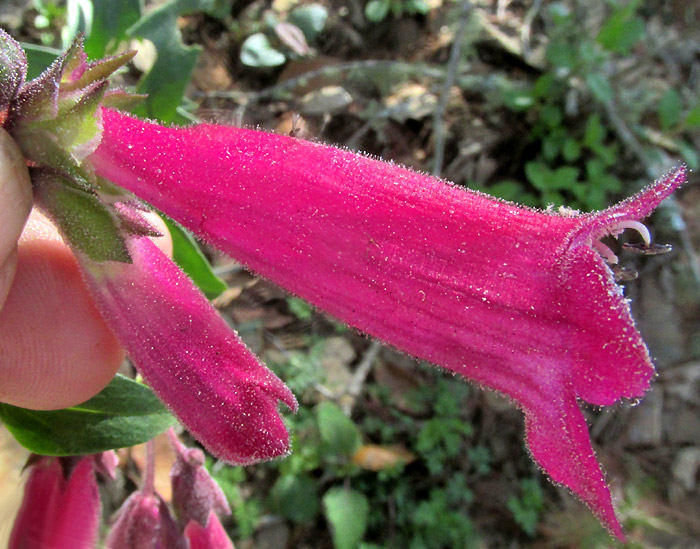Excerpts from Jim Conrad's
Naturalist Newsletter
Entry from field notes dated September 2, 2023, taken in Los Mármoles National Park in the Eastern Sierra Madre mountains, Hidalgo state, MÉXICO; near oak-pine forested slope along road leading to Puerto de Piedra, which branches off the road between Trancas {on maps designated "Morelos (Trancas)"} and Nicolás Flores; limestone bedrock; elevation ~2,550m (~8,400ft); ~N20.81°, ~W99.23°
HARTWEG'S BEARDTONGUE

Sometimes you meet something so unexpectedly pretty that it knocks your socks off. That happened at the above place as I wandered through a somewhat somber, severe-drought-stunned oak-pine forest. In crystalline mountain air, the plant glowed in a beam of sunlight, with dark forest as background.

The blossoms, about 4cm long (1½in), nodded atop what at first appeared to be long, slender pedicels. However, notice that each actual pedicel attached to a calyx's base is short, with an even shorter, leafy scale, or bracteole, arising below, separating the pedicel and the much longer stalk, or rachilla, which functions as if it were a long pedicel. Such hair-splitting details are important for identification.

Above, each of the four stamens bear a dark anther consisting of two pollen sacs. Hardly visible with its rounded, white tip appearing between the pairs of stamens, is a sterile stamen, a staminode, like a typical stamen's filament lacking an anther. The presence of such a staminode in such a corolla with four regular stamens is a major field mark. Notice that the tips of the short hairs back-lighted at the corolla lobes' margins are enlarged and glistening. The hairs are gland-tipped, and most of each corolla's surface is densely covered with such glandular hairs, as seen below:

About at the center of the top of the corolla tube a gnat seems to be stuck to the glands. At the corolla's mouth, notice how the stamens' white filaments curve downward, positioning the blackish anthers so that when a bee enters, its top parts will be dusted with pollen.

Pairs of leaves without petioles arose opposite one another on straight, stiff stems. The rounded-bottom blades bore no indentations along their margins, except insect-chewed ones, and no teeth. These are important identification features for this species.
Gardeners and northern wildflower sniffers may recognize this fine plant as a kind of penstemon, or beardtongue. When you see four big stamens with that sterile staminode between them inside the inflated corolla, you can be sure of it: genus Penstemon. You can see another variation on the Penstemon theme with the recently encountered Bellflower Beardtongue.
The 2021 study by José Luis Villaseñor and others entitled "Riqueza y distribución de la flora vascular del estado de Hidalgo, México" reports that here in upland central Mexico's Hidalgo state nine beardtongue species, genus Penstemon, are documented.
It's not surprising that we'd have so many beardtongue species here, for the genus Penstemon, embracing about 280 species, all native just to the Americas, is the largest genus of flowering plants endemic to North America. Many North American species extend southward into the cool Mexican highlands, sometimes even into Central America's higher elevations.
Of the nine beardtongue species found here in Hidalgo state, if you meet one in the forest whose leaf bases are broadly rounded, and whose margins are entire, with no teeth, the corolla tube is inflated at the top but narrows gradually to the base, and the corolla is magenta with dark streaks forming nectar guides leading into the flower's bottom, you have PENSTEMON HARTWEGII, known as Hartweg's Beardtongue.
Hartweg's Beardtongue is endemic just to the highland forests of central Mexico, in the states of Puebla, México, Veracruz, San Luis Potosí, Querétaro and here in Hidalgo.
The species bears an English name because its pretty flowers haven't been ignored by the garden industry. Hatweg's Beardtongue is widely marketed to gardeners in many countries, though usually what's sold is a cultivar developed from our wild Mexican stock. There's the white-flowered 'Albus,' the bright-red 'Scarlet Queen' and 'Phoenix Red,' the big-blossomed "Picotee Red," and more. The species has gained the Royal Horticultural society's Award of Garden Merit.
In this area the species is medicinal. The 2012 study by José Luis Molina-Mendoza and others entitled "Plantas Medicinales y Listado Florístico Preliminar del Municipio de Huasca de Ocampo, Hidalgo, México," reports that here in Hidalgo the plant is used to treat bites from poisonous animals and for healing wounds.
Penstemon hartwegii is named in honor of the German Botanist Karl Theodor Hartweg, who collected plants in Mexico from 1836 to 1839. His collections went to other botanists who, for new discoveries, formally published the names and descriptions. Our Hartweg's Beardtongue was surrounded by Pinus hartwegii, which often is called Hartweg's Pine. I'll bet Hartweg gave a whoop when he saw our plant.